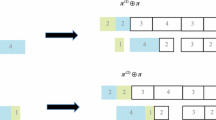Abstract
Bagga [1967] andJohnson [1954] developed algorithms for finding an optimum sequence, whenn jobs require processing on two machines. The criteria chosen by them were minimum waiting time of jobs and minimum elapsed time respectively. All then jobs were assumed to be of the same type i.e., all have to be processed on two machinesA andB in the orderAB. This paper presents a procedure for finding the optimal schedule of the jobs, when the jobs may be of the following types:
-
(a)
Jobs which are to be processed on only one of the machines.
-
(b)
Jobs which require processing on the two machinesA andB in the orderAB; and
-
(c)
Jobs which require processing on the two machinesA andB in the orderBA.
Similar content being viewed by others
References
Bagga, P. C.: Minimizing Waiting Time of Jabs over two machine scheduling problem. Defence Science Journal, April 1967.
Johnson, S. M.: Optimal two and three stage production schedule with set up time included. Naval Res. Log. Quart.1, 61–68, 1954.
Jackson, J. R.: An extension of Johnson's results on job lot scheduling. Naval Res. Log. Quart.3, 201–203, 1956.
Author information
Authors and Affiliations
Rights and permissions
About this article
Cite this article
Bagga, P.C. Two machine scheduling problem when passing allowed. Metrika 20, 36–40 (1973). https://doi.org/10.1007/BF01893798
Received:
Issue Date:
DOI: https://doi.org/10.1007/BF01893798




